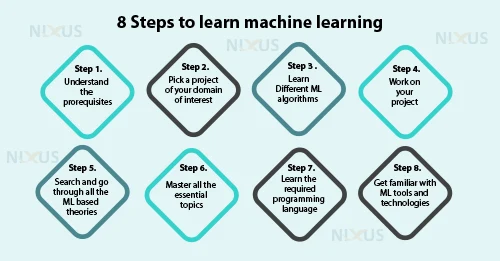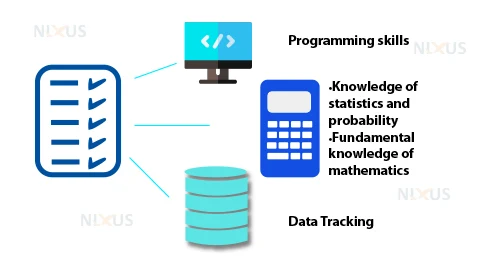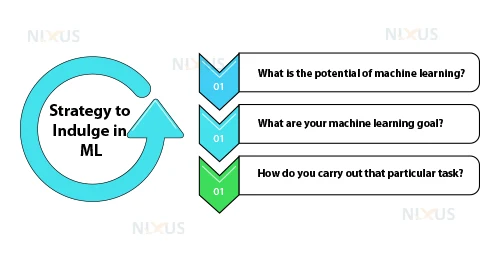Best Way to Learn Machine Learning
Machine learning (ML), a branch of artificial intelligence (AI), is the branch of computational science that is concerned with the analysis and interpretation of structures and patterns in information to facilitate learning and decision-making without the involvement of a human. Simply defined, machine learning enables an individual to provide a computer algorithm with an enormous amount of data and have the computer analyze and generate data-driven suggestions and decisions based solely on the input data. If any improvements are found, the algorithm can use that knowledge to make future decisions that are better.
Based on the problems, ML algorithms are classified into three types- Supervised Learning, Unsupervised Learning and Reinforcement Learning. Supervised learning is used in most practical ML applications. In supervised learning, sample “labelled” data is given to the machine learning algorithm as training data, and then it uses that information to predict the outcome.
Unsupervised learning is a subcategory of machine learning in which unlabeled datasets are used, which allows the model to operate on data without any supervision. The goal of unsupervised learning is to uncover relevant insights and hidden patterns from an unknown dataset.
In the case of reinforcement learning, to achieve a specific objective, a system communicates with a dynamic environment (for eg. vehicle driving or games with opponents). As the system moves through its problem area, it receives feedback in the form of rewards and penalties. With the help of these feedbacks, the agent automatically learns and performs better. To earn the greatest reward points, an agent strives and, as a result, performs better.
Manufacturing, healthcare, retail, travel and hospitality, stock market, financial services, as well as energy and utilities, are just a few of the sectors where machine learning is used. Data science and machine learning careers have grown rapidly in recent years. In particular, machine learning is a thriving and quickly developing discipline that presents enormous prospects for growth.
As a result, ML is becoming a basic need, and hence, every ML admirer who wants to dive into this technology must have a proper passage to follow. This article has come up with a single-door solution to this problem.
Simple Steps to Learn Machine Learning
In order to learn machine learning from scratch, the whole process has been divided into 8 simple steps. Let’s start with these steps:
- Understand the prerequisites
- Search and go through all the ML-based theories
- Master all the essential topics
- Read different ML projects and pick a project in your domain of interest
- Learn different ML algorithms (Refer to videos and textbooks)
- Learn the required programming language
- Get familiar with ML tools and technologies
- Work on your project
Step 1: Understand the prerequisites
You must first comprehend machine learning’s foundational ideas before learning about its theory and applications. By setting up a structured learning route, this foundation will make it easier for you to understand ML fundamentals.
Without a basic introduction to its fundamentals, machine learning can seem difficult. To master machine learning, you don’t have to be an expert programmer or mathematician, however, you ought to possess the fundamental knowledge in those fields.
The best part is that the remainder will be quite simple once the requirements are met. In fact, the majority of machine learning (ML) involves concepts from computer science and statistics principles to analyze data. Ensure that you are up to date in statistics and programming, at the very least.
Following is the list of some prerequisites that are to be considered while learning ML:
1. Programming skills (Python, R, or JAVA)
- Python: Programming language popularity rankings consistently place Python among the top three. If you’re just starting to learn a programming language, Python can be a good option because it’s relatively simple to master.
- R: R is a programming language which is open-source in nature and is used for statistical computing and data analysis. R typically includes a command-line interface.
- JAVA: Java is both a platform and a programming language. Programming with Java is high-level, object-oriented, robust, and secure.
2. Knowledge of statistics and probability: Reducing the likelihood of inaccuracy in the machine’s decision-making and final output is the main goal of machine learning. So, it should come as no surprise that statistics and probability are important.
3. Fundamental knowledge of mathematics: In order to comprehend and use algorithms in a variety of applications, one must have knowledge of mathematics. Every stage of the machine learning process incorporates mathematical ideas, from picking the appropriate method to selecting the appropriate parameter.
4. Data tackling: Since the whole idea of ML revolves around data and its implementation, there exist a lot of steps to make that data perfect for accurate and reliable results. Some of the steps are Acquiring the dataset, handling the missing or noisy data, feature engineering, or encoding the type of data.
Step 2: Search and go through all the ML-based theories
To learn anything, you must first spend some time figuring out where things stop and where your interests lie.
There are two key advantages to this:
- Your focus will improve because you’ll know you’re not missing anything by being aware of the size of the field.
- Knowing the appearance of the environment you are walking through will make it simpler to sketch a path in your mental picture.
You should respond to these three questions in the following order to fully indulge yourself in the field and fine-tune your learning strategy:
- What is the potential of machine learning?
- What are your machine learning goals?
- How do you carry out that particular task?
With the help of these questions, you’ll be able to focus on a subject that is both easy to study and very specific while still getting a sense of the big picture.
Step 3: Master all the essential topics
You will begin to comprehend the capabilities and logic of machine learning models if you have a firm understanding of the underlying ideas. The last stage before you can start making contributions to the ML community is to develop a complete understanding of the workflow of data science activities. This will make it easier for you to grasp how the data, machine learning, and software code pipelines communicate to produce a finished output.
Focused practice focuses on employing careful, targeted activities to sharpen your abilities. This step has three objectives:
- Go through the complete workflow of ML: This includes data gathering, cleaning process, and preprocessing for machine learning.
- Building models, tuning and assessment also come into this objective.
- Working with datasets: By using actual datasets, you can get an intuitive sense of the models that are most suited for specific challenges.
- Understanding individual subjects/topics: Let’s assume that in objective 1, you learned about clustering methods. Objective 2 involves applying various clustering algorithms to datasets to determine which ones perform the best.
You’ll be prepared to take on projects of your choice after completing this step without experiencing stress.
Step 4: Read different ML projects and pick a project as per your area of interest
It’s time to be more precise now that you are clear on your objectives and have a general notion of how you plan to accomplish them.
Seeing a real expert at work is the best method to fully understand how to do something.
More context for your learning will be provided than by any theory if you can see the outcome of where you are seeking to take action.
The simplest method to accomplish this is to look through public projects. Go at a couple of them until you discover one that speaks to you, or choose the one that appeals to you the best.
Do invest some time to review the documentation, the coding, and the codebase once you have that project. You’ll probably get lost, especially if you don’t have much experience with coding. But while learning anything new, this is a good feeling!
Make notes on any recurring patterns you notice, intriguing details you comprehend, or subjects you aren’t entirely sure about. Save this project so you can return to it after continuing your learning.
Step 5: Learn different ML algorithms (Refer to videos and textbooks).
Since you have gathered enough knowledge, you can now easily understand different ML algorithms and their process of implementation. However, there exists a need to indulge in the inner workings of each algorithm specifically before you can really understand machine learning. The most detailed explanations are likely to utilize high-level math. You might refer to stepwise instructions written in a programming language (Python, R, or any other) if you don’t like descriptions that involve a lot of math.
At the end of your learning experience, you will be able to build a variety of algorithms (linear, nonlinear, and ensemble) as well as comprehend the machine learning approaches used to import and prepare the data.
The full range of topics that should be covered are listed as:
- Data scaling
- baseline models
- algorithm test harness
- linear regression
- logistic regression
- KNN
- bootstrap aggregation
Step 6: Learn the required programming language
Every algorithm used in machine learning is implemented using code. Each aspiring ML engineer must, therefore, have programming knowledge in Java, Python, R, or Bash. The most widely used programming language in recent years, particularly among newcomers, has been Python. It features the supported libraries, the simplest syntax, and broad package support. It also contains a large number of built-in functions.
`A beginner’s or crash course in Python is the easiest method to get started with machine learning if you have no prior programming knowledge. You must learn how to collect, process, and evaluate data after mastering its fundamental functions. There will often be a section on effective data analysis in most Machine Learning and data science courses.
Step 7: Get familiar with ML tools and technologies
Currently, a staggering variety of ML tools and packages are available. Combinations can range from data collection and preparation through model generation and application deployment, and they are essentially limitless. Staying with tried-and-true tools and packages with verified functioning is your safest move as a beginner. Of course, the tools you select will also depend on the kind of model and forecast you are trying to build. Yet, a large range of tried-and-true tools produce excellent outcomes for the vast majority of applications.
The most common ML tools and technologies to learn are the following:
- Python: for high-level programming language
- Pandas: for manipulation of datasets
- Numpy: for computation of numerical data over CPU
- Scikit-learn: used for non-deep learning ML models
- Tensorflow or Pytorch: for Deep Learning based ML models
- Keras and fast.ai libraries
- Git: used while working on your project
- Jupyter Notebook or Google Colab: for code implementation
The aforementioned technologies are sufficient for the majority of projects.
However, other libraries may need to be included in your stack since they are particular to your field of study.
Step 8: Work on your project
The actual step, where the majority of learning will occur, is now. You should be able to compile together a project that is just marginally usable at this point with the very minimum of usefulness.
As a beginner, working on a simple project that is easily doable would help you develop a variety of new skills. Just thought it could look better in your portfolio, don’t choose a more difficult assignment. After finishing a few simple projects, you can at any time go on to more complicated subjects. If you are comfortable with your grasp of a basic project, you can try an intermediate-level project listed below.
- text mining,
- market basket analysis,
- a movie recommendation engine or
- text summarization with natural language processing (NLP).
Conclusion
As we have discussed the whole process of learning ML in a step-by-step manner, we can say that if you followed the instructions and finished the assignments, you are more adept at using ML than 90% of the people who call themselves data scientists.
But again, the key to success is to keep learning and, hence, never stop exploring if you want to be the finest data scientist or engineer in machine learning. Welcome to the beginning of your journey in this exciting and dynamic area!


